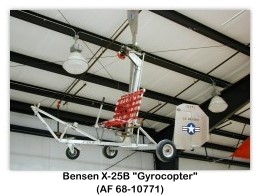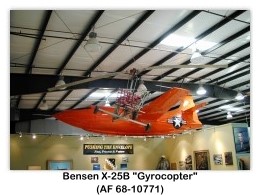
| ||||
|---|---|---|---|---|
 |
 |
 |
 |
 |



























| ||||
|---|---|---|---|---|
 |
 |
 |
 |
 |


























Bensen X-25B "Discretionary Descent Vehicle" (DDV)
United States: USAF single-seat light autogyro
Archive Photos
Bensen X-25B (AF 68-10771) at the Air Force Flight Test Center Museum, Edwards AFB, CA


Overview
The Bensen B-8 is a small, single-seat autogyro developed in the United States in the 1950s. Although the original manufacturer stopped production in 1987, plans for homebuilders are still available as of 2007. Its design was a refinement of the Bensen B-7, and like that aircraft, the B-8 was initially built as an unpowered rotor-kite. It first flew in this form in 1955, and on 6 December a powered version, designated B-8M (M for motorized) first flew. The design proved to be extremely popular and long-lasting, with thousands of sets of plans sold over the next thirty years.
Design and Development
The B-8’s design is extremely minimalist, with not much more to the aircraft than a pilot’s seat, a single tailfin, a rotor and (in powered versions) the powerplant. In May 1968 a B-8 and B-8M were studied by the USAF under the Discretionary Descent Vehicle (DDV) program as the X-25B and X-25A respectively. In this scheme, it was proposed to integrate combat aircraft ejection seats with a small autogyro or rotor kite to allow downed pilots more control over their post-ejection landing spot. The X-25A and X-25B were used to evaluate the piloting and training requirements of the autogyros. No full-scale operational tests were ever performed. The U.S. Air Force stopped funding the DDV program with the end of the Vietnam War.
One B-8M, named "Spirit of Kitty Hawk" (N2588B) was used to make a special commemorative flight exactly duplicating the first flight of the Wright brothers’ original Flyer on the sixtieth anniversary of the occasion. This same aircraft was flown by Igor Bensen himself between May 1967 and June 1968 to set twelve world and US speed, distance, and altitude records for autogyros, the largest number of such records to be held by any non-military rotorcraft.
Variants
Specifications (Typical B-8M)
General Characteristics
Performance
Bensen X-25A "Gyrocopter"
Two X-25 aircraft were procured by the USAF in 1968 to test a method for improving the chances of rescuing crewmen forced to bail out from their aircraft over enemy territory. If the flyer had a means of controlling his descent after parachuting and could select a landing site, his chances of avoiding capture would be greatly increased. The unpowered Bensen X-25B "Gyroglider" theoretically could be deployed after the flyer’s parachute had opened. Its rotary wings would be brought up to speed during the descent, the parachute would be detached, and the "Gyroglider" would then be flown as an autogiro to a landing point. The X-25A "Gyrocopter" represented a more advanced concept with a limited "fly-away" capability. Unlike the X-25B, which had no engine, the X-25A had a 90-hp engine.
Specifications (Bensen X-25A)
References